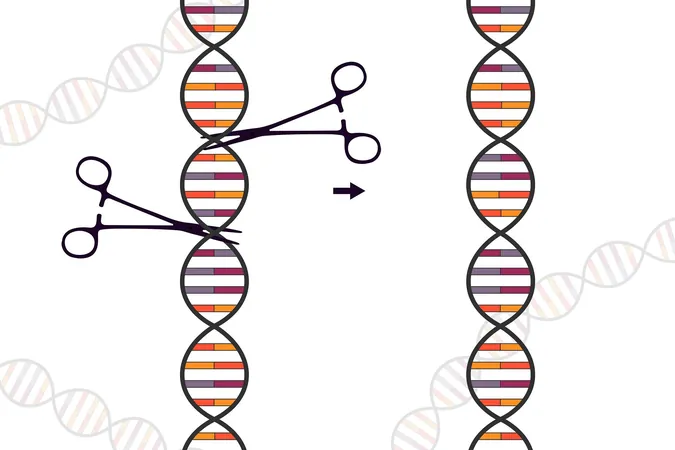
Unlocking the Secrets of the PRPS Enzyme: A Key to Precision Medicine
2025-07-08
Author: Emma
A Journey Through Evolution and Medicine
Researchers at the University of Cincinnati Cancer Center are delving billions of years into evolutionary history, uncovering insights that could revolutionize the future of precision medicine. Their latest study, published in *Nature Communications*, centers on the enigmatic PRPS enzyme complex, vital for cellular biochemistry.
The PRPS Enzyme Complex Explained
Phosphoribosyl pyrophosphate synthetase (PRPS) is an evolutionary cornerstone, with mammalian cells producing four key proteins: PRPS1, PRPS2, and two associated proteins, AP1 and AP2. Traditionally, scientific focus has been on PRPS1 and PRPS2, often sidelining AP1 and AP2 despite their mysterious existence. Karki, the study's lead author, describes AP1 and AP2 as "zombie" enzymes—present but lacking catalytic activity.
Why Did Evolution Favor Them?
Curiosity drove the research team to investigate why these so-called "dead" enzymes remained throughout evolutionary history. Karki emphasizes the significance of evolutionary conservation: if a gene persists, it must be performing a crucial role. This study sought to unveil that role.
Tracing Evolutionary Roots
The researchers meticulously traced the lineage of PRPS-encoding genes across mammalian cells. The ancestral PRPS1 enzyme found its way into eukaryotes through a bacterial ancestor billions of years ago. Over time, AP2 emerged in the evolutionary line leading to animals and fungi, followed by the appearance of AP1 and PRPS2 through a gene duplication event.
This preservation across various jawed vertebrates, including sharks and mammals, highlights the importance of these proteins, critical for metabolic adaptability in advanced lifeforms. Cunningham, a co-author, points out that the presence of multiple PRPS genes is nearly universal in eukaryotes, a stark contrast to their absence in bacteria.
Unlocking the Complex's Functionality
To understand the importance of the PRPS components, the researchers employed CRISPR gene-editing technology, knocking out different enzyme combinations in mammalian cells. Remarkably, the overall fitness of the cells plummeted when only PRPS1 was present. This led to slow growth and fewer nucleotides, underscoring the necessity of all four enzymes for cellular function.
The Structure of Cooperation
Using size-exclusion chromatography, the team discovered the four enzymes form a substantial complex within cells, significantly larger than the structures formed when any individual enzyme is absent. Surprisingly, this complex destabilized when AP1 or AP2 were missing, revealing their role as molecular scaffolds vital for the enzyme structure.
The Need for Collective Study
Karki insists that studying these enzymes in isolation only reveals a fraction of the story. Interactions among all four proteins are crucial for their active and regulatory functions. With many diseases tied to PRPS deregulation, this comprehensive understanding could unlock new avenues for therapies.
Towards Personalized Medicine
Given that PRPS enzymes are key in converting sugars into nucleotides—fundamental building blocks of RNA and DNA—therapeutic strategies could be tailored accordingly. In the context of cancer, inhibiting PRPS activity may slow tumor growth, while boosting it could assist in treating nucleotide deficiency syndromes.
This study lays the foundational knowledge necessary to translate scientific breakthroughs into innovative diagnostics and treatments, offering hope for improving patient outcomes in the future.









 Brasil (PT)
Brasil (PT)
 Canada (EN)
Canada (EN)
 Chile (ES)
Chile (ES)
 Česko (CS)
Česko (CS)
 대한민국 (KO)
대한민국 (KO)
 España (ES)
España (ES)
 France (FR)
France (FR)
 Hong Kong (EN)
Hong Kong (EN)
 Italia (IT)
Italia (IT)
 日本 (JA)
日本 (JA)
 Magyarország (HU)
Magyarország (HU)
 Norge (NO)
Norge (NO)
 Polska (PL)
Polska (PL)
 Schweiz (DE)
Schweiz (DE)
 Singapore (EN)
Singapore (EN)
 Sverige (SV)
Sverige (SV)
 Suomi (FI)
Suomi (FI)
 Türkiye (TR)
Türkiye (TR)
 الإمارات العربية المتحدة (AR)
الإمارات العربية المتحدة (AR)